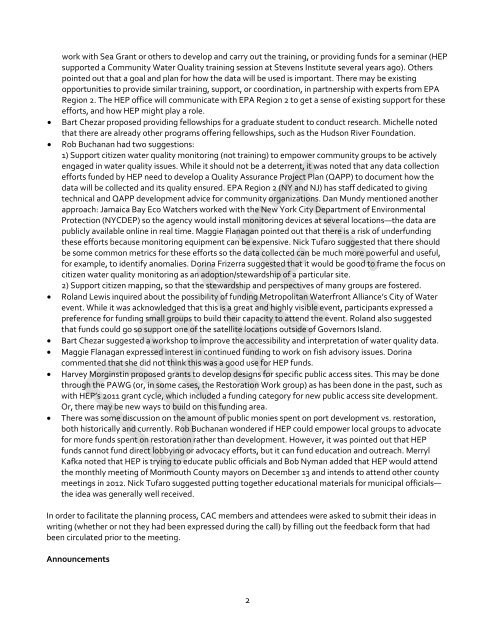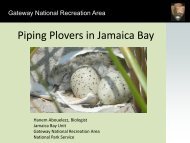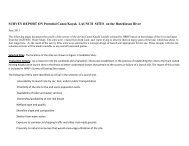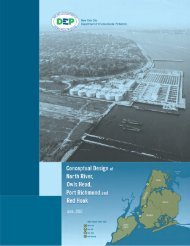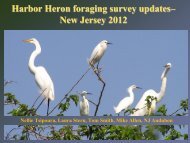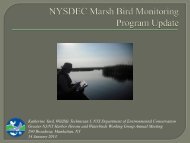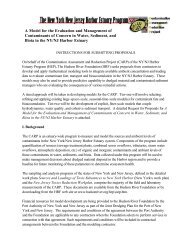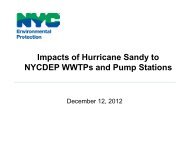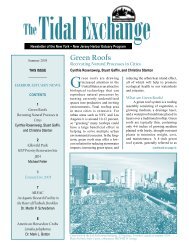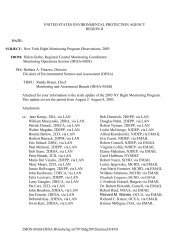cac-pawg-11dec8 .pdf - New York-New Jersey Harbor Estuary ...
cac-pawg-11dec8 .pdf - New York-New Jersey Harbor Estuary ...
cac-pawg-11dec8 .pdf - New York-New Jersey Harbor Estuary ...
Create successful ePaper yourself
Turn your PDF publications into a flip-book with our unique Google optimized e-Paper software.
work with Sea Grant or others to develop and carry out the training, or providing funds for a seminar (HEPsupported a Community Water Quality training session at Stevens Institute several years ago). Otherspointed out that a goal and plan for how the data will be used is important. There may be existingopportunities to provide similar training, support, or coordination, in partnership with experts from EPARegion 2. The HEP office will communicate with EPA Region 2 to get a sense of existing support for theseefforts, and how HEP might play a role.• Bart Chezar proposed providing fellowships for a graduate student to conduct research. Michelle notedthat there are already other programs offering fellowships, such as the Hudson River Foundation.• Rob Buchanan had two suggestions:1) Support citizen water quality monitoring (not training) to empower community groups to be activelyengaged in water quality issues. While it should not be a deterrent, it was noted that any data collectionefforts funded by HEP need to develop a Quality Assurance Project Plan (QAPP) to document how thedata will be collected and its quality ensured. EPA Region 2 (NY and NJ) has staff dedicated to givingtechnical and QAPP development advice for community organizations. Dan Mundy mentioned anotherapproach: Jamaica Bay Eco Watchers worked with the <strong>New</strong> <strong>York</strong> City Department of EnvironmentalProtection (NYCDEP) so the agency would install monitoring devices at several locations—the data arepublicly available online in real time. Maggie Flanagan pointed out that there is a risk of underfundingthese efforts because monitoring equipment can be expensive. Nick Tufaro suggested that there shouldbe some common metrics for these efforts so the data collected can be much more powerful and useful,for example, to identify anomalies. Dorina Frizerra suggested that it would be good to frame the focus oncitizen water quality monitoring as an adoption/stewardship of a particular site.2) Support citizen mapping, so that the stewardship and perspectives of many groups are fostered.• Roland Lewis inquired about the possibility of funding Metropolitan Waterfront Alliance’s City of Waterevent. While it was acknowledged that this is a great and highly visible event, participants expressed apreference for funding small groups to build their capacity to attend the event. Roland also suggestedthat funds could go so support one of the satellite locations outside of Governors Island.• Bart Chezar suggested a workshop to improve the accessibility and interpretation of water quality data.• Maggie Flanagan expressed interest in continued funding to work on fish advisory issues. Dorinacommented that she did not think this was a good use for HEP funds.• Harvey Morginstin proposed grants to develop designs for specific public access sites. This may be donethrough the PAWG (or, in some cases, the Restoration Work group) as has been done in the past, such aswith HEP’s 2011 grant cycle, which included a funding category for new public access site development.Or, there may be new ways to build on this funding area.• There was some discussion on the amount of public monies spent on port development vs. restoration,both historically and currently. Rob Buchanan wondered if HEP could empower local groups to advocatefor more funds spent on restoration rather than development. However, it was pointed out that HEPfunds cannot fund direct lobbying or advo<strong>cac</strong>y efforts, but it can fund education and outreach. MerrylKafka noted that HEP is trying to educate public officials and Bob Nyman added that HEP would attendthe monthly meeting of Monmouth County mayors on December 13 and intends to attend other countymeetings in 2012. Nick Tufaro suggested putting together educational materials for municipal officials—the idea was generally well received.In order to facilitate the planning process, CAC members and attendees were asked to submit their ideas inwriting (whether or not they had been expressed during the call) by filling out the feedback form that hadbeen circulated prior to the meeting.Announcements2


